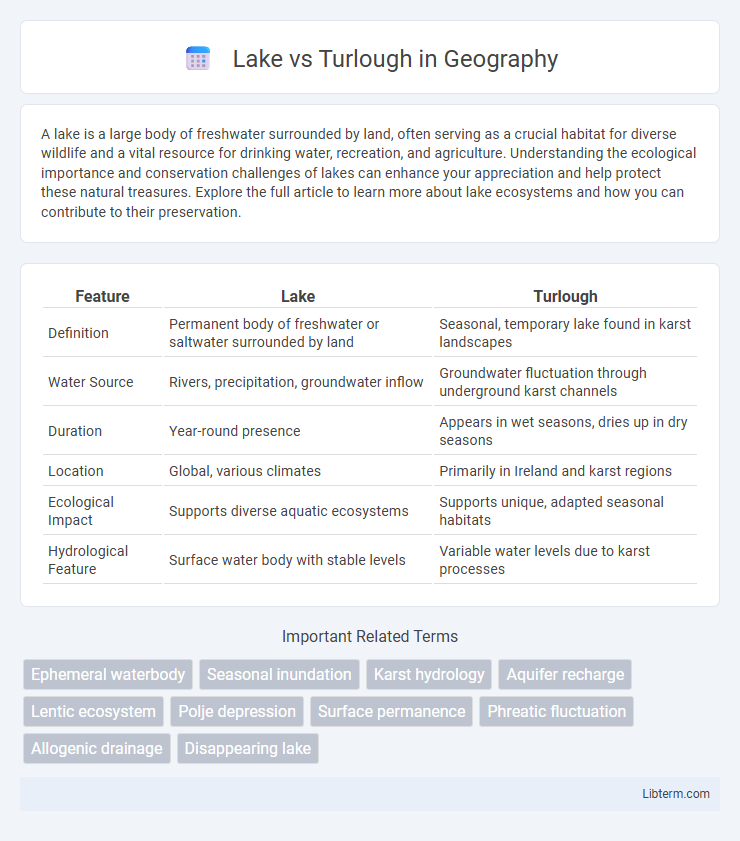A lake is a large body of freshwater surrounded by land, often serving as a crucial habitat for diverse wildlife and a vital resource for drinking water, recreation, and agriculture. Understanding the ecological importance and conservation challenges of lakes can enhance your appreciation and help protect these natural treasures. Explore the full article to learn more about lake ecosystems and how you can contribute to their preservation.
Table of Comparison
| Feature | Lake | Turlough |
|---|---|---|
| Definition | Permanent body of freshwater or saltwater surrounded by land | Seasonal, temporary lake found in karst landscapes |
| Water Source | Rivers, precipitation, groundwater inflow | Groundwater fluctuation through underground karst channels |
| Duration | Year-round presence | Appears in wet seasons, dries up in dry seasons |
| Location | Global, various climates | Primarily in Ireland and karst regions |
| Ecological Impact | Supports diverse aquatic ecosystems | Supports unique, adapted seasonal habitats |
| Hydrological Feature | Surface water body with stable levels | Variable water levels due to karst processes |
Introduction: Understanding Lakes and Turloughs
Lakes are large, permanent bodies of freshwater or saltwater, typically formed by geological and hydrological processes such as glacial activity, tectonic movements, or river damming. Turloughs are unique to karst landscapes, particularly in Ireland, characterized by seasonal flooding where the lake appears and disappears due to underground limestone drainage. Understanding the distinct hydrological and geological features of lakes and turloughs aids in appreciating their ecological significance and management challenges.
Definitions: What Is a Lake? What Is a Turlough?
A lake is a large, permanent body of freshwater or saltwater, formed naturally or artificially, and typically surrounded by land. A turlough is a seasonal karstic lake found primarily in limestone regions of Ireland, characterized by its cyclical filling and draining due to underground water flow. While lakes remain filled year-round, turloughs are unique for their intermittent presence, appearing during wet seasons and disappearing in dry periods.
Formation Processes: How Lakes and Turloughs Develop
Lakes form primarily through tectonic activity, glacial erosion, volcanic craters, or river damming, resulting in persistent bodies of freshwater. Turloughs develop in karst regions where soluble limestone bedrock dissolves to create underground drainage systems, causing seasonal flooding in shallow depressions. This cyclical water presence distinguishes turloughs from more stable lake ecosystems.
Hydrology: Water Sources and Fluctuations
Lakes receive water primarily from rivers, streams, rainfall, and groundwater inflows, maintaining relatively stable water levels depending on seasonal and climatic variations. Turloughs are unique karstic features found mainly in limestone regions, filling intermittently through underground aquifers and seasonal rainfall, causing significant fluctuations or complete drying at times. Hydrologically, lakes function as consistent water reservoirs, while turloughs demonstrate dynamic water regimes controlled by subterranean hydrology and surface water interactions.
Geographical Distribution and Occurrence
Lakes are widespread geographical features found on every continent, primarily in regions with sufficient precipitation, glacial activity, or tectonic depressions, commonly occurring in temperate and polar zones. Turloughs are unique to Ireland and parts of western Britain, characterized by their seasonal presence in karst limestone landscapes where groundwater fluctuations create intermittent lakes. While lakes maintain permanent water bodies, turloughs exhibit cyclical drying and flooding driven by underground water table changes.
Ecological Significance and Biodiversity
Lakes are permanent freshwater bodies that support diverse aquatic ecosystems, providing habitats for fish, amphibians, and a wide range of plant species, contributing to high biodiversity and ecological stability. Turloughs, seasonal karstic lakes found primarily in Ireland, create unique ecological niches through periodic flooding and drying, supporting specialized flora and fauna adapted to fluctuating water levels. Both lake types play crucial roles in nutrient cycling, water purification, and serve as vital breeding grounds for migratory birds and endemic species.
Seasonal and Environmental Variations
Lakes exhibit relatively stable water levels year-round, influenced mainly by rainfall and inflow sources, supporting consistent aquatic ecosystems. Turloughs are seasonal karst wetlands found primarily in Ireland, characterized by periodic flooding during wetter months and drying out in drier periods, creating unique habitats for specialized flora and fauna. Environmental variations in turloughs dramatically affect biodiversity, while lakes maintain more stable ecological conditions due to their continuous water presence.
Human Impact and Land Use
Lakes often experience significant human impact through urbanization, agriculture, and recreational activities that alter water quality and biodiversity. Turloughs, seasonal karst depressions primarily found in Ireland, face unique land use challenges as their intermittent flooding supports traditional grazing but is vulnerable to drainage and land reclamation attempts. Both ecosystems require careful land management to balance human needs with conservation of their distinct hydrological and ecological characteristics.
Cultural and Historical Importance
Lakes have long held significant cultural and historical importance as centers for settlement, trade, and spiritual practices across diverse civilizations, often featuring in folklore and rituals. Turloughs, unique seasonal lakes found mainly in Ireland, carry ecological and cultural value by influencing agricultural cycles and inspiring local legends tied to the land's natural rhythm. Both water bodies symbolize the deep relationship between communities and their environment, shaping cultural identities and historical narratives over centuries.
Conclusion: Key Differences and Implications
Lakes are permanent bodies of freshwater with stable water levels, supporting diverse ecosystems and recreational activities year-round. Turloughs are seasonal karstic wetlands that fill during wetter months and dry out in warmer seasons, creating unique habitats adapted to fluctuating conditions. Understanding these hydrological and ecological differences is crucial for effective water management and conservation strategies in their respective environments.
Lake Infographic

 libterm.com
libterm.com